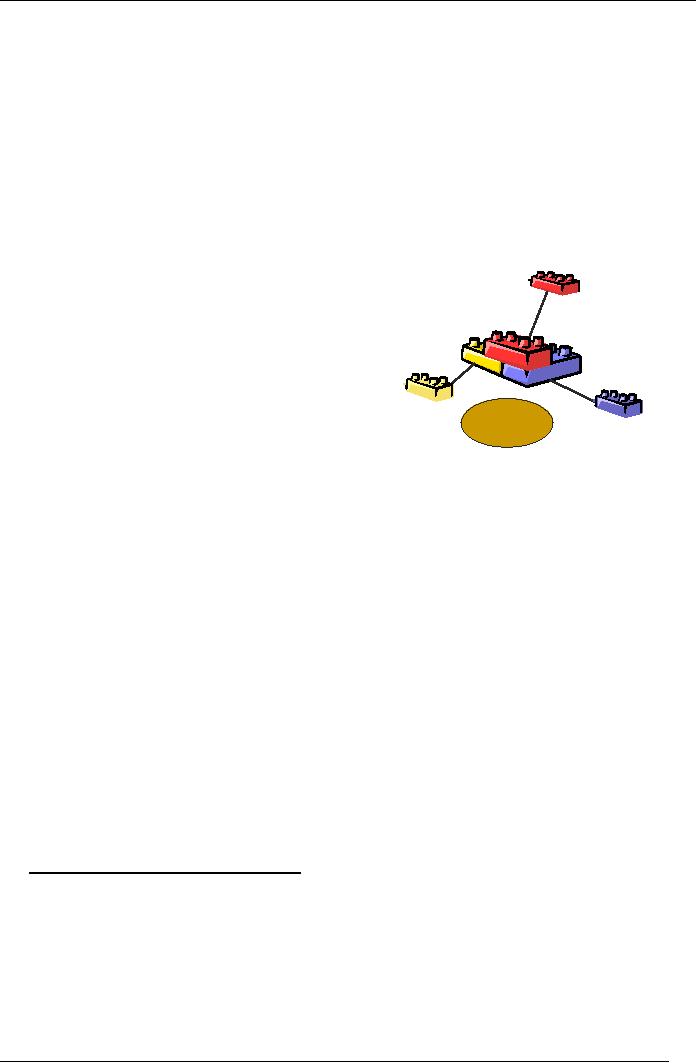 |
INTRODUCTION TO HRM:Growing Importance of HRM, Road Map of the Course |
| ESSENTIALS OF MANAGEMENT:Concepts and Essential of Management, Manager’s Roles >> |

Human
Resource Management
(MGT501)
VU
Lesson
1
INTRODUCTION
TO HRM
After
studying this chapter, students should be
able to understand the
following:
Describe
HRM?
Explain
why are we concerned about
HRM?
Discuss
Road-map of HRM
LESSON
OVERVIEW
This
chapter introduces the students
with the basic concepts of the
human resource management
(HRM).
During
the lecture, we will be discussing the
three
main
things, i.e. the introduction to
HRM, the
importance
of HRM, and a brief
discussion of the
Resource
topics
that will follow today's
lecture.
A
basic concept of management
states that manager
works
in organizations. Organization has three
basic
components,
People, Purpose, and
Structure. HRM is
the
study of activates regarding people
working in an Human
Management
organization.
It is a managerial function that
tries to
match
an organization's needs to the skills and
abilities
of
its employees. Let's see what is meant by
the three
HRM
key
terms... human, resource,
and management.
·
Human
(Homo-sapiens Social
Animal)
Dr.
Mukhtar Ahmed
·
Resources
(Human, Physical, Financial, Technical,
Informational etc)
·
Management
(Function of Planning, Organizing, Leading &
Controlling
of
organizational
resources
to accomplish goals efficiently
and effectively)
Functions
of HRM
Basic
functions that all managers
perform: planning, organizing, staffing,
leading, and controlling.
HR
management
involves the policies and practices
needed to carry out the
staffing (or people) function
of
management.
HRM
department regardless of the organization's size
must perform following human
resource
management
functions...
·
Staffing
(HR planning, recruitment and
selection)
·
Human
resource development
·
Compensation
and benefits
·
Safety
and health
·
Employee
and labor relations
·
Records
maintaining, etc.
·
HR
research (providing a HR information
base, designing and implementing
employee
communication
system).
·
Interrelationship
of HR functions.
A.
What is human resource
management?
As
we said that HRM is the management of
people working in an organization, it is a subject
related to
human.
For simplicity, we can say
that it is the management of humans or
people. HRM is a managerial
function
that tries to match an organization's
needs to the skills and abilities of
its employees. Human
Resource
Management is responsible for
how people are managed in the
organizations. It is responsible
for
bringing
people in organization helping them perform
their work, compensating them
for their work
and
solving
problems that arise.
Growing
Importance of HRM
The
success of organizations increasingly
depends on people-embodied know-how- the knowledge,
skill,
2

Human
Resource Management
(MGT501)
VU
and
abilities imbedded in an organization's
members. This knowledge base is the
foundation of an
organization'
core competencies (integrated knowledge
sets within an organization that
distinguish it from
its
competitors and deliver value to
customers).
HRM
plays
important role in creating
organizations and helping them survive.
Our world is an
organizational
world. We are surrounded by organizations
and we participate in them as
members,
employees,
customers, and clients. Most
of our life is spent in organization,
and they supply the goods
and
services
on which we depend to live. Organizations
on the other hand depend on people,
and
without people,
they
would disappear.
Factors
Contributing to the Growing
Importance of HRM
a.
Accommodation to workers'
needs
Workers
are demanding that
organizations accommodate their
personal needs by instituting
such programs
as
flexible work schedules,
parental leave, child-care
and elder-care assistance,
and job sharing. The
human
resource
department plays a central role in
establishing and implementing policies
designed to reduce the
friction
between organizational demands and
family responsibilities.
b.
Increased complexity of the Manager's
job
Management
has become an increasingly complex
and demanding job for
many reasons, including
foreign
competition,
new technology, expanding scientific information,
and rapid change. Therefore,
organizations
frequently
ask human resource managers
for assistance in making strategic
business decisions and in
match-
ing
the distinctive competencies of the firm's
human resources to the mission of the
organization.
Executives
need assistance from the
human resource department in matters of
recruitment, performance
evaluation,
compensation, and discipline.
c.
Legislation and litigation
The
enactment of state laws has
contributed enormously to the
proliferation and importance of
human
resource
functions. The record keeping and
reporting requirements of the laws
are so extensive that
to
comply
with them, many human
resource departments must
work countless hours and
often must hire
additional
staff.
Four
areas that have been
influenced most by legislation include equal
employment, Compensation, safety,
and
labor relations. An organization's
failure to comply with laws regulating
these areas can result
in
extremely
costly back-pay awards,
class action suits, and
penalties.
d.
Consistency
Human
resource policies help to maintain
consistency and equity within an
organization. Consistency is
particularly
important in compensation and
promotion decisions. When
managers make
compensation
decisions
without consulting the human resource
department the salary structure tends to
become very
uneven
and unfair promotion
decisions also may be handled
unfairly when the HR department does
not
coordinate
the decision of individual
manger.
e.
Expertise
Now
a days there exist
sophisticated personnel activities
that require special expertise.
For example,
researchers
have developed complex procedures for
making employee-selection decisions;
statistical
formulas
that combine interviews, test scores,
and application-blank information
have replaced the
subjective
interviews traditionally used in making
selection decisions. Similarly, many
organizations have
developed
compensation systems with
elaborate benefits packages to replace
simple hourly pay or piece
rate
incentive
systems
f.
Cost of Human
Resource
Human
resource activities have become
increasingly important because of the
high cost of personal
problem.
The largest single expense
in most organizations is labor
cost, which is often
considerably higher
than
the necessary because of such
problems as absenteeism tardiness
and discrimination.
3

Human
Resource Management
(MGT501)
VU
B.
Why are we concerned with
HRM?
1.
Helps you get results -
through others.
Different
managerial techniques help
mangers to direct the performance of
employees in desirable
direction
in
order to achieve the organizational
objectives. Through the efforts of
others working in an organization,
managers
get things done that require effective
human resource
management.
2.
Helps you avoid common
personnel mistakes
Qualified
HR mangers utilize organization resources
in such a way that helps to
avoid common personnel
mistakes
like the following...
a.
Hiring
the wrong person for the
job
b.
Experiencing
high turnover
c.
Finding
employees not doing their
best
d.
Having
your company taken to court
because of your discriminatory
actions
e.
Having
your company cited under
federal occupational safety laws
for unsafe practices
f.
Allowing
a lack of training to undermine your
department's effectiveness
g.
Committing
any unfair labor
practices
3.
Helps you to gain Competitive
Advantage
Among
all the resources possessed by the
organizations it is only Manpower or the
Human resources that
create
the real difference. Because all
organizations can have the
same technology, they can possess
same
type
of financial resources, same sort of
raw material can be used to
produce the goods and
services but the
organizational
source that can really
create the difference is work force of the
organization. Therefore they
are
the main sources of innovation creativity
in the organizations that can be
used as a competitive
advantage.
In today's competitive
environment,
these
are the people which can
create competitive
S
u c c e s s fu l H R M
advantageous
for the organizations.
The
world around us is changing. No longer
can we
O
r g a n iz a t i o n
: H
ig h le v e l o f p ro fita b ilit y
,
H
ig h e r a n n u a l s a le s p e r e m p lo y e e , H ig
h
consider
our share of the "good Life"
given. If we
m
a rk e t v a lu e .
are
to maintain some semblance of that
life, we as
E
m p l o y e e
: M
o re e m p lo y m e n t s e c u r ity ,
individual,
as organizations, as society will
have to
M
o re jo b o p p o rt u n itie s , H ig h w a g e s
.
fight
actively for it an increasingly
competitive
global
environment. If organizations are
able to
S
o c i e t y
: E
le v a tin g th e s t a n d a rd o f liv in g
,
S
tre n g th e n in g e th ic a l g u id e lin e s
.
mange
its work force efficiently/effectively
this will
be
beneficial for all stakeholders
(Organization,
Dr.
Mukhtar Ahm ed
Employees
and Society).
Challenges/Issues
of Managing Human Resources in present
era
Following
are the main issues that
are faced by the mangers to
manage the workforce of
today's
organization
for achievement of
objectives.
a.
To Attract People
People
will be interested to join
any organization if it is providing them
quality working
environment,
attractive
benefit and opportunities to
excel in future. Keeping in
view the opportunities in the market,
the
first
issues will be to attract
good people for your
organization.
b.
To Develop People
Development
is related to provide the opportunities
for training and development to
match the skills to
job
in
particular areas. It requires careful
need assessment for training
and selecting effective training
methods
and
tools. After attracting/selecting, Continuous development of
workforce of the organization
leads
towards
development of the organization. So that they will
start playing their important
role in the
organization.
4

Human
Resource Management
(MGT501)
VU
c.
To Motivate
Motivation
means to influence performance of others
and to redirect the efforts in desirable
direction by
using
different motivational tools that
can help in fulfilling the
mission of organization. Third
important
issues/concern
will be to keep your
workforce motivated so that they should
keep on delivering
effectively.
d.
To Keep Talented People
This
is related to retention of workforce in
organization and to take steps
that can prevent
undesirable
detachments
of talented and motivated workers
from the organization.
C.
Discussion on the road-map of
HRM
For
the convenience and attainment of our
course objectives, we divide
our course into 42 modules.
Each
module
includes information for you
to acquire and understand,
issues for you to consider,
and skills for
you
to develop.
Road
Map of the Course
The
list of topics, which we
call the `road map' of this
course, is given below...
1.
Introduction
2.
Basic
concepts of management and
its relationships with HRM
3.
Components
of an organization
4.
Concepts
of people working together
5.
Individual
vs. Group behavior and
Teams
6.
History
of HRM
7.
New
trends at workplace with changing
environment
8.
Workforce
diversity, pros and
cons
9.
Functions
of HRM
10.
Relationship
between HR specialist and
line managers
11.
Legal
and ethical issues in
HRM
12.
Human
resource planning (HRP)Human
resource information system
(HRIS)
14.
Job
analysis
15.
Job
analysis continued Job
analysis outcomes.
16.
Recruitment
17.
Source
of recruitment
18.
Selection
19.
Selection
Tests
20.
Selection
process, continued
21.
Socialization
22.
Training
& development
23.
Maximizing
learning
24.
Career
management
25.
Performance
Performance Appraisal
27.
Job
evaluation and pricing
28.
Compensation
system
29.
Benefits
30.
Role
of money in performance of
employee
31.
MotivationOccupation
health and safety
33.
Stress
management
34.
Communication
in organization
Trade
union
35.
36.
Conflict
and Negotiation
37.
Power
& politics
38.
Discipline
39.
HR
auditing
5

Human
Resource Management
(MGT501)
VU
40.
HR
control process
41.
Leadership
42.
Leadership
in organization
43.
Employee
separation
44.
International
dimension of HRM
45.
Conclusion
& Review.
Key
Terms
Human
Resource
Management
The
staffing functions of the management
process. Or the policies
and
practices
needed to carry out the
"people" or human resource
aspects of a
management
position, including recruiting,
screening, training,
rewarding,
and
appraising etc.
Manager
Individuals
in an organization who direct the activities of
others. Member
of
the organization performing the management
function
Motivation:
Motivation
means to influence performance of others
and to redirect the
efforts
in desirable direction by using
different motivational tools
that can
help
in fulfilling the mission of
organization
Organization
A
systematic arrangement of people to
accomplish some specific
purpose.
Competitive
Advantage
Any
factor that allows an organization to
differentiate its product
or
service
from those of its competitors to
increase market
share.
Stakeholders
All
individuals and groups that
are directly or indirectly affected by
an
organization's
decisions
6
Table of Contents:
- INTRODUCTION TO HRM:Growing Importance of HRM, Road Map of the Course
- ESSENTIALS OF MANAGEMENT:Concepts and Essential of Management, Manager’s Roles
- ORGANIZATION AND COMPONENTS OF ORGANIZATION:Open versus Closed Systems, The Hawthorne Studies
- PEOPLE AND THEIR BEHAVIOR:Why to work in organizations?, The Goals of Organizational Behavior
- INDIVIDUAL VS. GROUP BEHAVIOR:What Are Roles?, Problem solving Team
- PERSONNEL MANAGEMENT TO HUMAN RESOURCE MANAGEMENT:Records and Administration, Competitive Advantage
- HRM IN A CHANGING ENVIRONMENT:Productivity, New Trends at Work Place
- How organization Cultivate a Diverse Workforce, STEPS TOWARD MANAGEMENT OF DIVERSITY
- FUNCTIONS AND ENVIRONMENT OF HRM:Compensation and Benefits, Safety And Health, Interrelationships of HRM Functions
- LINE AND STAFF ASPECTS OF HRM:Authority, Line versus Staff Authority, Staff Manager
- LEGAL CONTEXT OF HR DECISIONS:Doing the Right Thing, Affirmative Action, Unintended Consequences
- HUMAN RESOURCE PLANNING (HRP):Benefits of HR Planning, Forecasting Human Resource Availability
- STRATEGIC PLANNING AND HRIS:HR’s Strategic Role, Human Resource Information System, Common HRIS Functions
- JOB ANALYSIS:Purposes of the job Analysis, Questions Job Analysis Should Answer
- JOB ANALYSIS:Methods of Collecting Job Analysis Information, Observation, Source of Data
- JOB ANALYSIS (CONTD.):SURPLUS OF EMPLOYEES FORECASTED, Diversity through Recruiting Efforts
- SOURCES OF RECRUITMENT:ALTERNATIVES TO RECRUITMENT, Quantity of the Applicants, Quality of the Applicants
- SELECTION:Initial Screening, Advantages of Successful Screening
- SELECTION TESTS:Characteristics of Properly Designed Selection Tests, Guidelines for Conducting an Interview
- SELECTION PROCESS… CONTD:Background Investigations, Physical Exam, Selecting Managers
- SOCIALIZATION:Compensation and Benefits, Team Membership, Stages in socialization Process, Training and Development Trends
- TRAINING AND DEVELOPMENT:Learning, Phases of Training, Why Transfer of Training Fails
- MAXIMIZING LEARNING:Following up on Training, Repetition, Feedback, Purposes of T & D
- CAREER MANAGEMENT:Individual career planning, Career Planning and Development Methods
- PERFORMANCE:Determinants of Job Performance, Why is performance measured?, Performance Management
- PERFORMANCE APPRAISAL:What to Evaluate, The Appraisal Interview, PROBLEMS IN PERFORMANCE APPRAISAL
- JOB EVALUATION AND PRICING:THE APPRAISAL PERIOD, Ranking method,
- COMPENSATION SYSTEM:Pay, Job Pricing, Compensation: An Overview, Compensation Surveys
- BENEFITS:Total Compensation, Discretionary Benefits (Voluntary), Workplace Flexibility
- ROLE OF MONEY IN PERFORMANCE OF EMPLOYEES:Types of Pay-for-Performance Plans, Empower Employees
- MOTIVATION:The Motivation Process, Motivational Theories, Challenges of motivating employees
- OCCUPATION, HEALTH & SAFETY:Physical Conditions, Accident Investigation, Smoking in The work place
- STRESS MANAGEMENT:Symptoms of Stress, Managing Stress,
- COMMUNICATION IN ORGANIZATION:Burnout, Social Support at Work & Home, Communication in organization, Meetings
- TRADE UNIONS:Collective Bargaining, The HRM Department in a Nonunion Setting, Phases of Labor Relations
- CONFLICT AND NEGOTIATION:Transitions in Conflict Thought, Individual Conflict Management Styles
- POWER AND POLITICS:Sources of Power, Advantages and Disadvantages of PowerPower and Politics in Context
- EMPLOYEE RIGHTS AND DISCIPLINE:Contractual Rights, Management Rights, Disciplining Employees,
- DISCIPLINE (CONT...):Factors to Consider when Disciplining, Disciplinary Guidelines, Employee Separations
- LEADERSHIP:The Leader’s Behavior, Situational Theories of Leadership, Becoming a Leader
- REVISION (LESSON 12-21):Plans, Job Specification, Human resource planning, Selection Process, Corporate Culture
- REVISION (LESSON 22-26):Training, Case Study Method, Training, Performance
- REVISION (LESSON 27-35):Classification Method, Compensation, Empowerment, Mediation
- INTERNATIONAL DIMENSIONS OF HRM:Global Corporation, Type of staff members, Approaches to Global Staffing
- CONCLUSION & REVIEW:Strategies for Gaining Competitive Advantage, High-performance Work System